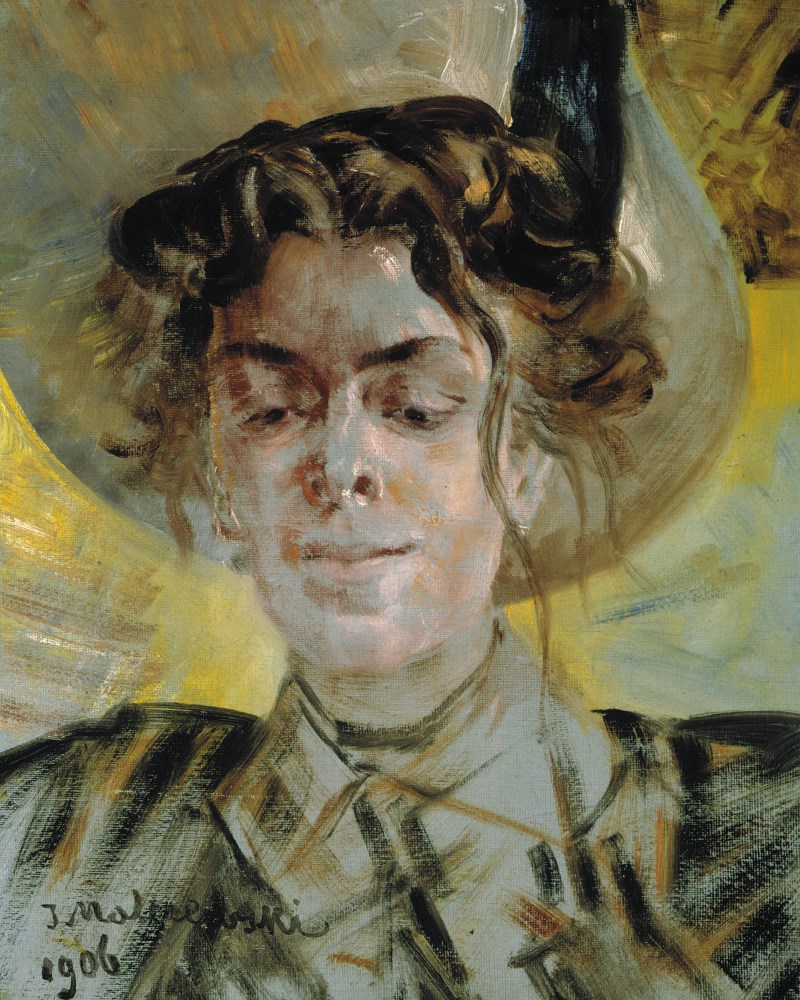Description:
Jack Malczewski (1854-1929) had a passion for art and Romantic literature, particularly the poetry of Juliusz Słowacki, which he inherited from his family. He came from a noble but not wealthy family, and his father Julian supported him in his artistic career. The events of 1863, the January Uprising and subsequent repression, had a particular impact on the young artist. His first teacher was Adolf Dygasiński. From 1867 to 1871 he spent his youth in the manor house of his relatives the Karczewskis in Wielgiem. In 1873 he began his studies at the School of Fine Arts in Kraków under the tutelage of Jan Matejko. He was a student of Władysław Łuszczkiewicz and also studied at the École des Beaux-Arts in Paris. He traveled to Italy, Vienna, Munich, Greece, and Asia Minor. From 1896 to 1900 and 1910 to 1914 he was a professor at the Academy of Fine Arts in Kraków. From 1912 to 1914 he was its rector. He began with an idealizing realism and then moved on to naturalism, with the plight of exiles to Siberia and the inspiration of Juliusz Słowacki’s “Anhelli” being the dominant themes of his work at this time. At the same time, fantastic and allegorical elements began to appear in Malczewski’s work. After his father’s death in 1884, the recurring theme in Malczewski’s work was Thanatos – the god of death. After 1890 his art became completely symbolic. Works that manifest this turn to a symbolic style are “Introduction” 1890, “Melancholy” 1890-1894, “Vicious Circle” 1895-1897. The artist addressed existential, historical and artistic topics, interweaving ancient and biblical motifs with the native folklore and the Polish landscape so important in his work. Form, colour, monumentality of the representations and their expressiveness became his trademark.
Description of the painting:
“Portrait of Maria Balowa” is the only portrait of the artist’s muse named by the name of the model*. Maria Balowa was a kind of ‘femme fatale’ in the life of Jacek Malczewski. Forbidden, beautiful, tempting, much younger and married, with whom acquaintance shaped the artist’s work, making a relationship a source of inspiration and creating the heroine of numerous paintings. “Love for a woman and love for the homeland are equally strong, but sometimes it is the first one that becomes the actual motivator of decisions and choices. In addition, it is a source of happiness, […]”****.
Although the painted figure appears in many works of Malczewski, in all of them except this one, it remains a beautiful, unnamed inspiration of the painter, in whose face features Stanisław Bal proudly found similarities to his wife**. Maria Balowa rarely used her proper name. Letters were often signed ‘Kinia Bal’. Jadwiga Maria Brunicka, later Balowa, changed her name to Maria Kinga. It was to be unique, like the personality of the woman who wore it.
Jack Malczewski’s work presents a portrait of a woman captured ‘en face’, facing the viewer. The model’s pale face is adorned with clearly outlined, dark eyebrows and her hair pulled back, whose curls could not be tamed by the hat placed on it. No joy is seen on the face, so clearly visible in the painting “Portrait of a Woman against a Tree”. This time we have an “official” portrait. The lips are closed, only slightly raised in the outline of a slight smile. Maria Balowa is not looking at the painter. Her eyes, covered with lowered eyelids, are directed downwards. The woman is lost in thought. She is dressed in a black costume and a white blouse. However, the entire attention of the artist focused on the face of the model. The other elements were only outlined with quick, sweeping strokes of the brush. The woman’s head was surrounded by a golden halo. It is a type of portrait rarely encountered in the work of Malczewski. There is no symbolic background or context. The whole work was taken over by one figure, beautiful and incredibly mysterious. “Towards her his thoughts, his emotions and his admiration ran. […] Beautiful like a finely carved jewel, like a diamond throwing off bright, multicoloured, glittering light. Life itself, joy, sun. It brightened his dark hours. With a roar, like a meteor, it burst into his life and, like a meteor, flew through, extinguished.”***.
The bond that connected Maria Balowa and Jacek Malczewski intertwined their biographies both in the field of art and everyday life. This relationship brought creative stimulation to the artist and Maria Balowa the possibility of contemplation of the world at the side of a kindred soul. “Thank you, my dearest, thank you and I lay my love at your feet, my happiness of spirit and yearning… Thank you for creating a new world for me, pure, ours alone. Secret and immense. […]”**. The relationship between the artist and his muse ended even before the outbreak of the First World War. In 1913, it was probably the last time they had the opportunity to meet.


